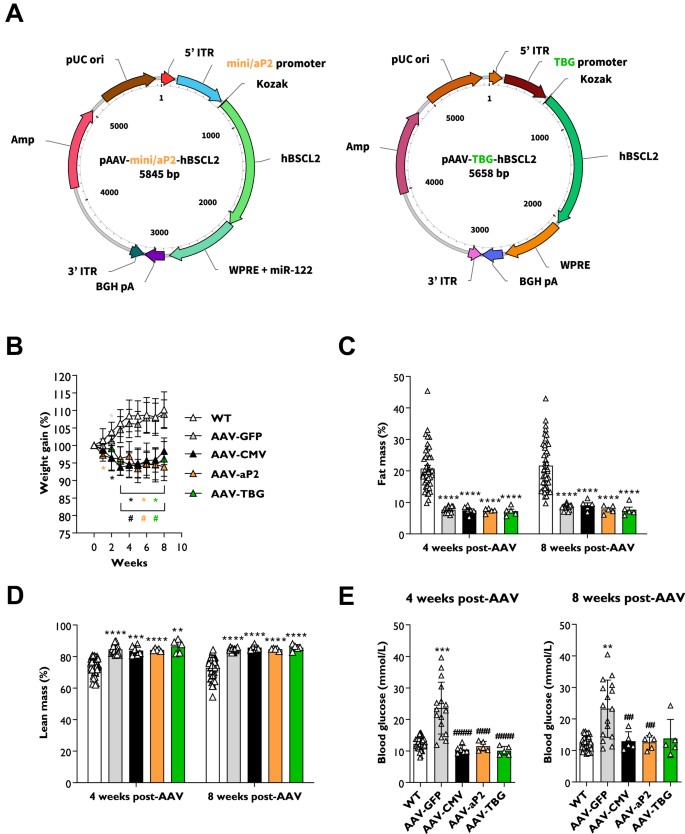Preclinical evaluation of tissue-selective gene therapies for congenital generalised lipodystrophy
IF 4.5
3区 医学
Q1 BIOCHEMISTRY & MOLECULAR BIOLOGY
引用次数: 0
Abstract
Lipodystrophy is a rare disorder which can be life-threatening. Here individuals fail to develop or maintain appropriate adipose tissue stores. This typically causes severe metabolic complications, including hepatic steatosis and lipoatrophic diabetes. There is no cure for lipodystrophy, and treatment options remain very limited. Here we evaluate whether tissue-selective adeno-associated virus (AAV) vectors can provide a targeted form of gene therapy for lipodystrophy, using a preclinical lipodystrophic mouse model of Bscl2 deficiency. We designed AAV vectors containing the mini/aP2 or thyroxine-binding globulin promoter to selectively target adipose or liver respectively. The AAV-aP2 vectors also contained the liver-specific microRNA-122 target sequence, restricting hepatic transgene expression. Systemic delivery of AAV-aP2 vectors overexpressing human BSCL2 restored adipose tissue development and metabolic health in lipodystrophic mice without detectable expression in the liver. High doses (1 × 1012 GCs) of liver-selective vectors led to off target expression and adipose tissue development, whilst low doses (1 × 1010 GCs) expressed selectively and robustly in the liver but did not improve metabolic health. This reveals that adipose tissue-selective, but not liver directed, AAV-mediated gene therapy is sufficient to substantially recover metabolic health in generalised lipodystrophy. This provides an exciting potential new avenue for an effective, targeted, and thereby safer therapeutic intervention.


先天性全身性脂肪营养不良的组织选择性基因疗法的临床前评估
脂肪营养不良是一种罕见的疾病,可危及生命。在这种疾病中,患者无法形成或维持适当的脂肪组织储存。这通常会导致严重的代谢并发症,包括肝脂肪变性和脂肪营养性糖尿病。脂肪营养不良无法治愈,治疗方案也非常有限。在这里,我们利用临床前脂肪营养不良小鼠模型 Bscl2 缺乏症,评估组织选择性腺相关病毒(AAV)载体能否为脂肪营养不良提供一种靶向性基因疗法。我们设计了含有 mini/aP2 或甲状腺素结合球蛋白启动子的 AAV 载体,分别选择性地靶向脂肪或肝脏。AAV-aP2载体还含有肝脏特异性microRNA-122靶序列,限制了肝脏转基因的表达。全身性递送过表达人BSCL2的AAV-aP2载体可恢复脂肪营养不良小鼠的脂肪组织发育和代谢健康,而肝脏中却检测不到表达。高剂量(1 × 1012 GCs)的肝脏选择性载体会导致脱靶表达和脂肪组织发育,而低剂量(1 × 1010 GCs)则会在肝脏中选择性地表达,但不会改善代谢健康。这揭示出,脂肪组织选择性而非肝脏定向的 AAV 介导的基因疗法足以大幅恢复全身性脂肪营养不良患者的代谢健康。这为有效、有针对性、从而更安全的治疗干预提供了一个令人兴奋的潜在新途径。
本文章由计算机程序翻译,如有差异,请以英文原文为准。
求助全文
约1分钟内获得全文
求助全文
来源期刊

Gene Therapy
医学-生化与分子生物学
CiteScore
9.70
自引率
2.00%
发文量
67
审稿时长
4-8 weeks
期刊介绍:
Gene Therapy covers both the research and clinical applications of novel therapeutic techniques based on a genetic component. Over the last few decades, significant advances in technologies ranging from identifying novel genetic targets that cause disease through to clinical studies, which show therapeutic benefit, have elevated this multidisciplinary field to the forefront of modern medicine.
 求助内容:
求助内容: 应助结果提醒方式:
应助结果提醒方式:


